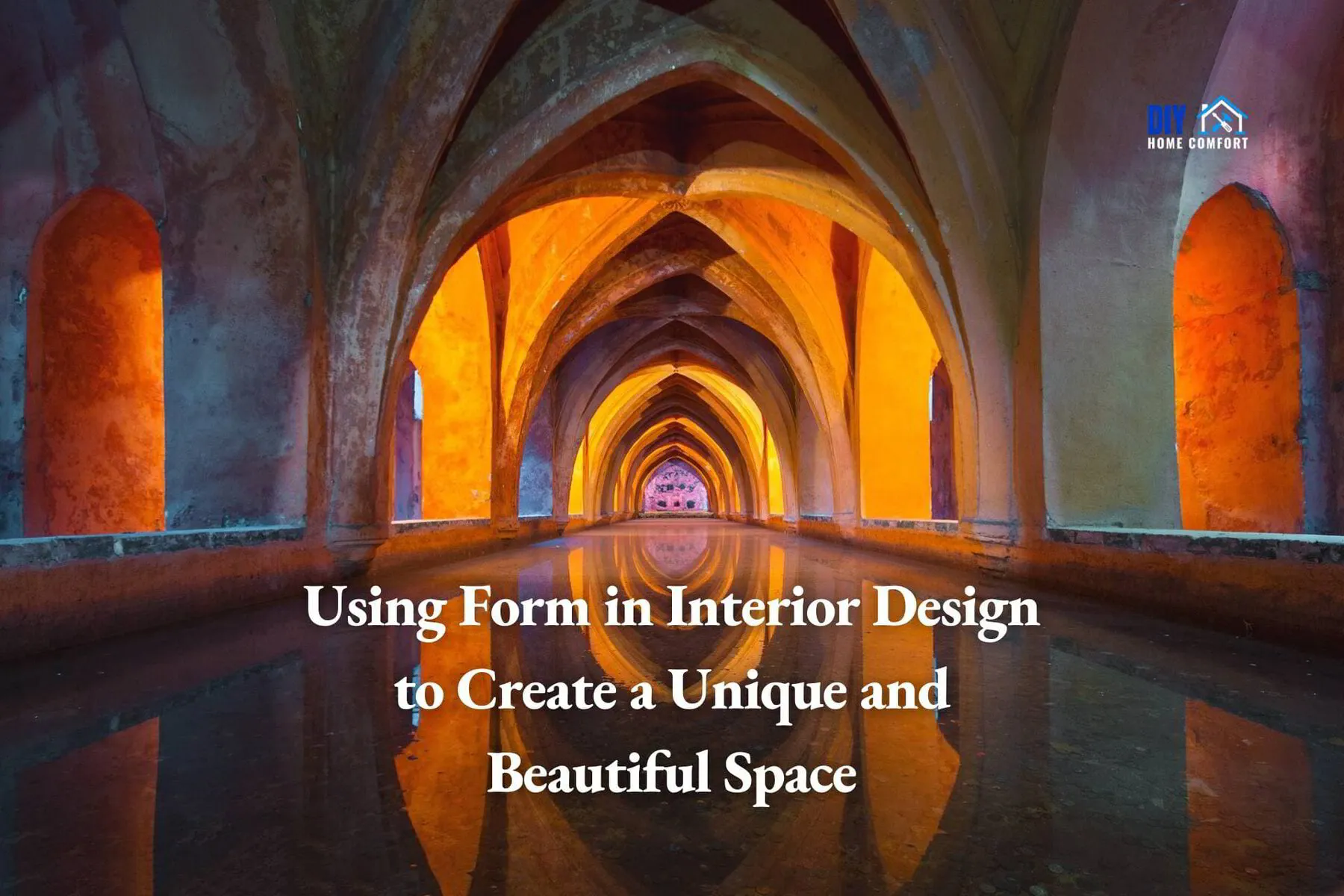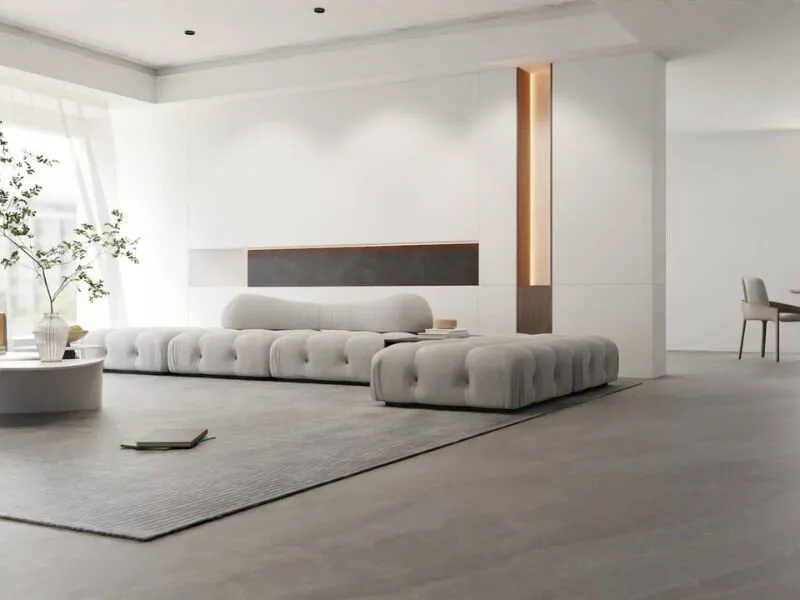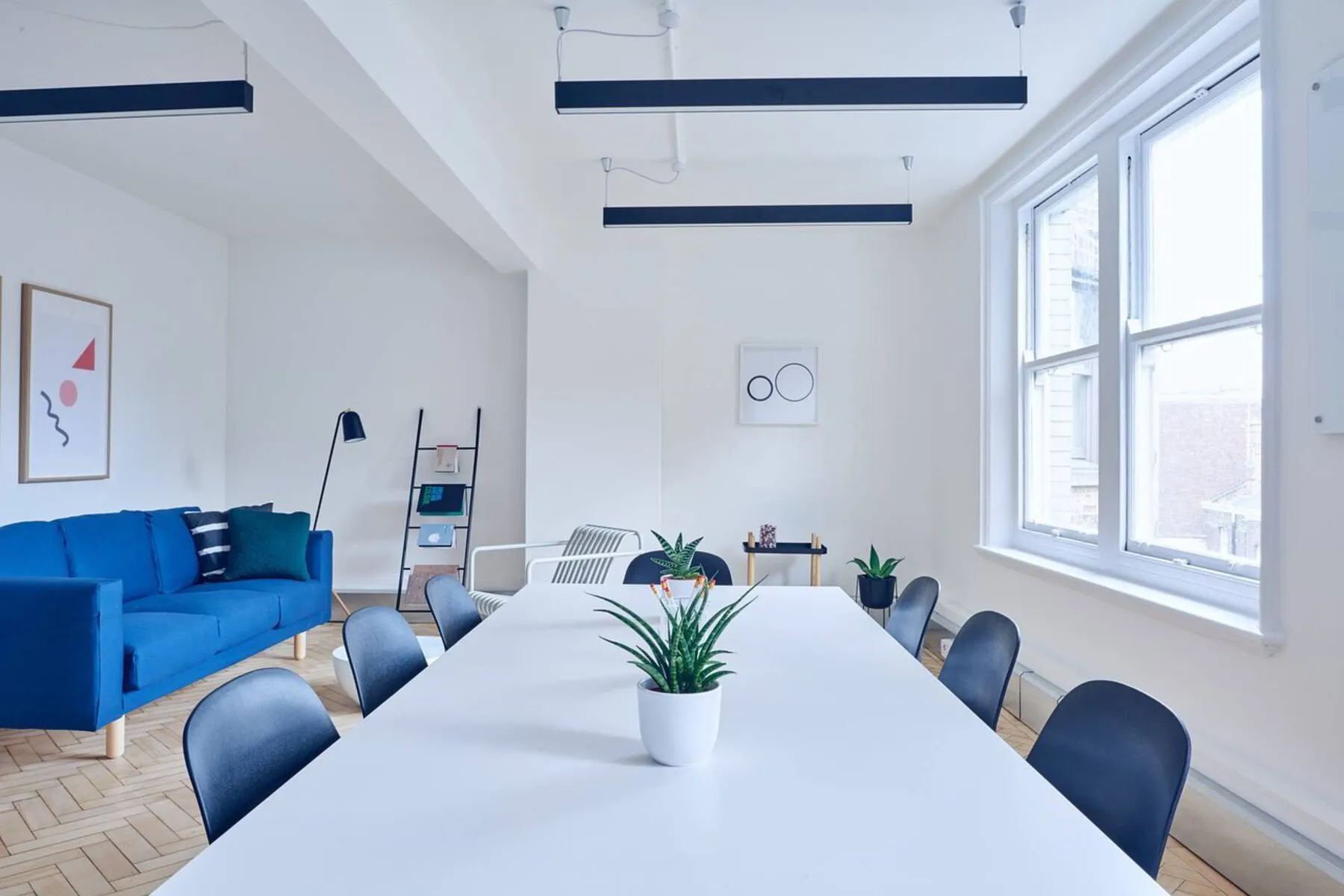Interior design is a complex and multi-faceted field that requires attention to detail and creativity. One of the 7 elements of interior design that can elevate a design to the next level is the use of form.
📘 Key Takeaways
- Form in interior design encompasses the shape, structure, and visual appearance of objects and spaces, influencing aesthetics and functionality.
- There are three primary forms: geometric (crisp lines and angles), organic (fluid and rounded), and abstract (open to interpretation).
- The choice of form significantly impacts space perception, with vertical forms making rooms appear taller and horizontal forms making them seem wider.
- Balancing positive forms with negative space is essential for harmony and avoiding a cluttered appearance.
- Incorporating various forms, from geometric to organic, enhances different design styles, creating a tailored and cohesive look.
What is Form in Interior Design?
In interior design, form is the shape, structure, and visual appearance of objects and spaces. By understanding and using form effectively, you can create a unique and beautiful space that reflects your personality and style.
Understanding the Role of Form in Interior Design
Interior design is all about creating a space that is both functional and aesthetically pleasing. Form, or the shapes and structures within a space, play a crucial role in achieving this balance.
By carefully choosing and incorporating different forms into your design, you can create a space that is not only visually appealing but also practical and comfortable.
Before we dive into the different types of forms and how to incorporate them into your design, let's first look at the basics of form, and how they impact the perception of space.
The Basics of Form in Interior Design
Form and shapes can be divided into two categories: geometric and organic.
Crisp, clean lines and angles define geometric forms, while organic forms are more fluid and rounded. Both types of forms can be used in interior design to create visual interest and balance.
Geometric form, such as square doors or rectangular furniture, can create a sense of order and structure within a space. On the other hand, organic forms can add a sense of movement and fluidity.
For example, a curved chair or table can soften the sharp lines of a room and create a more welcoming atmosphere.
How Form Influences the Perception of Space
The form you choose for your space will have a major impact on how it is perceived.
For example, using vertical form, such as a tall fireplace, floor lamps, and vertical lines can make a room appear taller. Alternatively, horizontal form like long sofas, low tables, and horizontal lines can make a room appear wider.
Understanding the relationship between forms and space can help you make strategic design choices that enhance your space. Another way form can influence the perception of space is through the use of negative space. Negative space is the area around and between forms.
By using negative space effectively, you can create a sense of balance and harmony within a space. For example, a room with no windows and a lot of small, cluttered forms can feel chaotic and overwhelming, while a room with larger, well-spaced forms can feel calm and serene.
The Relationship Between Forms and Function
Functionality is a key consideration in interior design, shape, and forms play a major role in determining how well a space functions. For example, a curved sofa may look beautiful, but it may not be as comfortable or practical as a more traditional style.
When choosing forms, it is important to consider form and function to ensure your space works well for your needs. Another consideration when choosing forms is the mood or atmosphere you want to create in a space.
For example, using angular and sharp forms can create a more modern and edgy atmosphere, while using softer, rounded forms can create a more relaxed and inviting atmosphere.
In conclusion, forms are a crucial element of interior design.
By understanding the basics of forms and shapes, how they influence the perception of space, and their relationship to function and atmosphere, you can create a space that is both beautiful and practical.
Types of Form in Interior Design
Now that we've covered the basics of forms in the 7 elements of interior design, let's take a closer look at the different types of forms you can incorporate into your space.
Geometric Form
Geometric forms have a strong and structured presence that can create a sense of order and balance in a space. Examples of geometric form include squares, rectangles, triangles, and circles. These forms can be incorporated into furniture, lighting, and accessories.
For example, a geometric-shaped coffee table can add a modern touch to a living room, while a geometric-patterned rug can add visual interest to a bedroom.
Organic Form
Organic forms are flowing and natural and can add a sense of softness and ease to a space.
Examples of organic forms include curved lines, irregular shapes, and other natural shapes and patterns like flowers and leaves. These forms can be incorporated into upholstery, rugs, and artwork.
For instance, a sofa with curved arms can create a cozy and inviting atmosphere in a living room, while a rug with a floral pattern can add a touch of nature to a bedroom.
Abstract Form
Abstract forms are less defined and more open to interpretation. They can add a sense of creativity and imagination to a space and can be incorporated into various design elements.
Examples of abstract shapes include unique sculptures, artwork, and other decorative accessories. For example, a colorful abstract painting can be a focal point in a dining room, while a unique sculpture can add a touch of whimsy to a hallway.
Combining Different Form for Visual Interest
While it's important to choose forms that work well together and support the function of your space, don't be afraid to mix and match different forms for added visual interest.
For example, combining geometric and organic form can create a sense of balance and harmony in a space.
Also, a geometric-shaped pendant light can be paired with a sofa with curved arms to create a well-balanced living room. Or, a natural-shaped vase can be placed on a geometric-shaped coffee table to add a touch of softness to a modern space.
Remember, the key is to experiment and find a combination of form that works best for your space and personal style.
Minimalist Design and Simple Form in Interior Design
Minimalist design is all about simplicity, and the use of simple form is a cornerstone of this style. Clean lines, neutral colors, and geometric shapes can create a minimalist aesthetic.
Look for furniture and accessories that have a refined and pared-down quality.
In a minimalist space, form should be used sparingly, but when they are used, they should be impactful. For example, a simple, geometric pendant light can add a striking focal point to a room or mood lighting without overwhelming the space.
When selecting forms for a minimalist space, consider the materials and textures of each piece. Natural materials such as wood, stone, and metal can add warmth, texture and depth to a minimalist space, while smooth, glossy surfaces can create a sleek and modern look.
📘 Related Reading: Top Tips on How To Live A Minimalist Life
Traditional Design and Classic Form in Interior Design
The traditional design focuses on classic, timeless forms with a sense of history and tradition. Furniture with ornate details, such as curved legs and intricate carvings, can add a sense of elegance and sophistication to a space.
Additionally, symmetrical form and balanced compositions are key to traditional design. In a traditional space, form should be used in a way that emphasizes symmetry and balance.
For example, a pair of matching table lamps can create a sense of harmony on a sideboard or console table.
When selecting forms for a traditional space, consider the materials and finishes of each piece. Rich, dark woods and plush fabrics can add a sense of luxury and opulence, while warm metals such as brass and copper can add a touch of glamour.
Modern Design and Bold Form in Interior Design
Modern design is all about bold forms and clean lines. Furniture and accessories with strong, simple shapes can create a sense of drama and impact in a space.
Look for forms with unexpected angles and negative and positive space to add visual interest. In a modern space, form should be dynamic lines used to create a sense of movement and energy.
For example, a sculptural coffee table with a dynamic form can add interest and a sense of excitement to a living room. When selecting form for a modern space, consider the materials and colors of each piece.
Bright, bold colors can add a playful element to a modern space, while monochromatic schemes with darker colors can create a sense of sophistication and elegance.
Eclectic Design and Mixed Form in Interior Design
Eclectic design is all about bringing together different styles and forms to create a unique and personalized space. Don't be afraid to mix and match different forms and styles to create your own unique look.
In an eclectic space, form should be used to create a sense of diversity and contrast. For example, a mix of vintage and modern form can create a sense of visual interest and intrigue.
When selecting form for an eclectic space, consider the colors, patterns, and textures of each piece. Mixing and matching different materials and finishes can add depth and complexity to an eclectic space, while a cohesive color palette can help tie everything together.
Choosing the Right Form for Your Room
When choosing form for your space, consider the function and purpose of each room.
For example, a bedroom should have soft, comfortable forms that promote relaxation and comfort. A dining room, on the other hand, can have more structured form that creates a sense of formality. Additionally, consider the size of the room and the forms you choose.
In a small room, too many large forms can make the entire space feel cramped and overwhelming, while in a large room, too many small forms can feel cluttered and insignificant.
Balancing Form and Negative Space
Positive and negative space in interior design refer to the physical objects and empty space around them, respectively, and are crucial for creating balance and harmony in the design.
It's important to balance the amount of negative space with the forms themselves to create a sense of harmony in your space. Avoid clutter and overly busy arrangements; instead, allow forms to breathe and have room to stand out.
However, don't be afraid to use negative space as a deliberate interior design choice. A minimalist approach incorporating a few carefully chosen forms in a space with plenty of negative space can create a striking and sophisticated look.
Using Form to Create Focal Points
Forms can be used to create focal points in your space, drawing the eye and creating a sense of visual interest. A large, bold form, like a unique sculpture or piece of artwork, can be the perfect focal point for a room.
However, be careful not to overdo it with too many focal points in one space. Choose one or two standout forms to create a cohesive and impactful design.
Enhancing Your Space with Form-Based Accessories
Accessories like vases, planters, and decorative objects can be excellent ways to incorporate forms into your space without committing to larger pieces like furniture.
Look for accessories that have unique forms and add character and personality to your space. Additionally, consider the materials and textures of these accessories.
A ceramic vase with a rough, textured surface can add visual interest and contrast to a space filled with smooth, sleek forms.
Creating Contrast with Form
Contrast is an important element of interior design, and form can be a great way to create contrast in your space.
For example, pairing a structured, geometric form with a soft, organic form can create a dynamic and interesting interior design.
Similarly, using forms in the same way as contrasting colors or materials can add visual interest and depth to a space.
Experimenting with Form Arrangements
Don't be afraid to experiment with different arrangements of form in your space. Try grouping forms of different sizes and shapes together to create a visually interesting display.
Alternatively, arrange forms in a symmetrical pattern for a more formal and balanced look. Remember, the possibilities are endless when it comes to using form in your space, so have fun and get creative!
Conclusion
As a budding interior designer, incorporating form into your interior design as part of the seven elements can take your space to the next level by creating a sense of balance, visual interest, and functionality.
Whether you prefer clean lines, organic shapes, or a more natural and flowing aesthetic, form can help create a unique and beautiful space that reflects your personality and style.
Interior Designers! Check out our other interior design articles in the series for more design inspiration.
Lara Harding
Lara is a supporting author @ DIY Home Comfort. She's an experienced interior designer and decorator and a full-time mom. You can find out more about her here.






